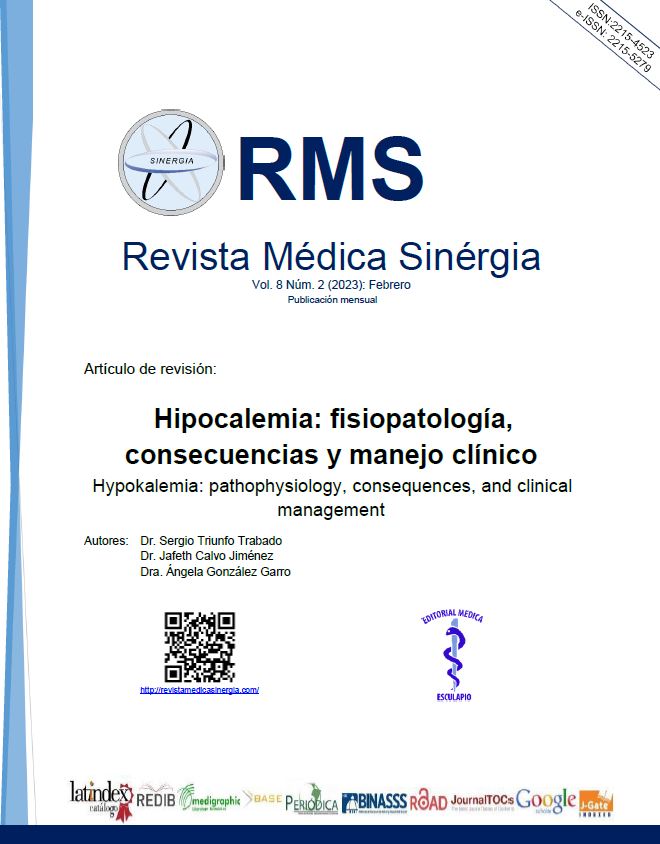Abstract
Hypokalemia is a commonly encountered electrolyte disturbance in clinical practice. As the predominant intracellular cation, potassium homeostasis ensures optimum cell functionality. Transient reductions in plasma potassium concentration depend on dietary intake and potassium excretion. An acceptable lower limit for serum potassium (K+) is 3.5 mmol/L. Although hypokalemia is well tolerated in healthy individuals, its severe cases can cause serious repercussions. The clinical manifestation of hypokalemia varies depending on the severity and duration of potassium loss from the body. Symptoms include heart palpitations, fatigue, muscle spasm, numbness, muscle twitches, and in severe cases cardiac arrhythmias and heart failure. The main route of K+ excretion is urine (90%) whereas a small amount (10%) is removed by GIT. External potassium losses are exacerbated in individuals with chronic diarrhea and prolonged sweating. Clinical history and examination are often sufficient to rule out the cause of hypokalemia. The overarching principle of hypokalemia therapy requires reducing potassium deficit, replenishing potassium reserves, and diagnosis and alleviation of causative factors to avoid future reoccurrences. Optimum recovery is reported in the majority of cases when underlying factors are eliminated. Potassium supplementation is paramount in all cases. The route of potassium administration should be based on the severity of the disease. The scope of this work is to provide a critical review of the pathophysiology, clinical diagnosis, and management of hypokalemia.
Keywords
References
Zoroddu MA, Aaseth J, Crisponi G, Medici S, Peana M, Nurchi VM. The essential metals for humans: a brief overview. Journal of inorganic biochemistry. 2019;195:120-9.
Skogestad J, Aronsen JM. Hypokalemia-induced arrhythmias and heart failure: new insights and implications for therapy. Frontiers in physiology. 2018;9:1500.
Fiaccadori E, Sabatino A, Barazzoni R, Carrero JJ, Cupisti A, De Waele E, et al. ESPEN guideline on clinical nutrition in hospitalized patients with acute or chronic kidney disease. Clinical Nutrition. 2021;40(4):1644-68.
Dhondup T, Qian Q. Acid-Base and Electrolyte Disorders in Patients with and without Chronic Kidney Disease: An Update. Kidney Dis (Basel). 2017;3(4):136-48.
Krogager ML, Torp-Pedersen C, Mortensen RN, Køber L, Gislason G, Søgaard P, et al. Short-term mortality risk of serum potassium levels in hypertension: a retrospective analysis of nationwide registry data. European heart journal. 2017;38(2):104-12.
Burrello J, Monticone S, Losano I, Cavaglia G, Buffolo F, Tetti M, et al. Prevalence of hypokalemia and primary aldosteronism in 5100 patients referred to a tertiary hypertension unit. Hypertension. 2020;75(4):1025-33.
Kardalas E, Paschou SA, Anagnostis P, Muscogiuri G, Siasos G, Vryonidou A. Hypokalemia: a clinical update. Endocr Connect. 2018;7(4):R135-r46.
Palmer BF, Clegg DJ. Blood pressure lowering and potassium intake. Nature Publishing Group; 2020. p. 671-2.
Calvo MS, Whiting SJ. School Meal Programs Require Higher Vitamin D Fortification Levels in Milk Products and Plant-based Alternatives: Evidence from the National Health and Nutrition Examination Surveys (NHANES 2001-18). Advances in Nutrition. 2022.
Kumssa DB, Joy EJ, Broadley MR. Global Trends (1961–2017) in human dietary potassium supplies. Nutrients. 2021;13(4):1369.
DeSalvo KB, Olson R, Casavale KO. Dietary Guidelines for Americans. Jama. 2016;315(5):457-8.
Sussman EJ, Singh B, Clegg D, Palmer BF, Kalantar-Zadeh K. Let them eat healthy: can emerging potassium binders help overcome dietary potassium restrictions in chronic kidney disease? Journal of Renal Nutrition. 2020;30(6):475-83.
Smith ZR, Horng M, Rech MA. Medication‐Induced Hyperlactatemia and Lactic Acidosis: A Systematic Review of the Literature. Pharmacotherapy: The Journal of Human Pharmacology and Drug Therapy. 2019;39(9):946-63.
Sharif S, Tang J. Potassium Derangements: A Pathophysiological Review, Diagnostic Approach, and Clinical Management. 2022.
Willson C. The clinical toxicology of caffeine: A review and case study. Toxicology reports. 2018;5:1140-52.
Holm-Yildiz S, Krag T, Witting N, Duno M, Soerensen T, Vissing J. Vacuoles, often containing glycogen, are a consistent finding in hypokalemic periodic paralysis. Journal of Neuropathology & Experimental Neurology. 2020;79(10):1127-9.
Hoorn EJ, Gritter M, Cuevas CA, Fenton RA. Regulation of the renal NaCl cotransporter and its role in potassium homeostasis. Physiological reviews. 2020;100(1):321-56.
Clase CM, Carrero J-J, Ellison DH, Grams ME, Hemmelgarn BR, Jardine MJ, et al. Potassium homeostasis and management of dyskalemia in kidney diseases: conclusions from a Kidney Disease: Improving Global Outcomes (KDIGO) Controversies Conference. Kidney international. 2020;97(1):42-61.
Long B, Warix JR, Koyfman A. Controversies in management of hyperkalemia. The journal of emergency medicine. 2018;55(2):192-205.
Ota R, Hirata A. Relationship between renal dysfunction and electrolyte abnormalities in hematopoietic stem cell transplant patients treated with foscarnet. Journal of Chemotherapy. 2021;33(8):539-46.
Khan S, Khan SU. Adverse drug event of hypokalaemia‐induced cardiotoxicity secondary to the use of laxatives: A systematic review of case reports. Journal of clinical pharmacy and therapeutics. 2020;45(5):927-36.
Tran TTT, Pease A, Wood AJ, Zajac JD, Mårtensson J, Bellomo R, et al. Review of Evidence for Adult Diabetic Ketoacidosis Management Protocols. Front Endocrinol (Lausanne). 2017;8:106.
Molin CZD, Trevisol DJ. Persistent severe hypokalemia: Gitelman syndrome and differential diagnosis. J Bras Nefrol. 2017;39(3):337-40.
Kovesdy CP, Appel LJ, Grams ME, Gutekunst L, McCullough PA, Palmer BF, et al. Potassium homeostasis in health and disease: A scientific workshop cosponsored by the National Kidney Foundation and the American Society of Hypertension. J Am Soc Hypertens. 2017;11(12):783-800.
Elsayes KM, Emad-Eldin S, Morani AC, Jensen CT. Practical Approach to Adrenal Imaging. Radiol Clin North Am. 2017;55(2):279-301.
Skogestad J, Aronsen JM. Hypokalemia-Induced Arrhythmias and Heart Failure: New Insights and Implications for Therapy. Front Physiol. 2018;9:1500.
Vanholder R, Van Biesen W, Nagler EV. Treating potassium disturbances: kill the killers but avoid overkill. Acta Clin Belg. 2019;74(4):215-28.
Iacobelli S, Guignard JP. Renal aspects of metabolic acid-base disorders in neonates. Pediatr Nephrol. 2020;35(2):221-8.
Shao D, Wang S, Zhou S, Cai Q, Zhang R, Li H, et al. Aldosteronism with mild hypokalemia presenting as life-threatening ventricular arrhythmias: A case report. Medicine (Baltimore). 2018;97(50):e13608.

This work is licensed under a Creative Commons Attribution-NonCommercial 4.0 International License.
Copyright (c) 2023 Array


